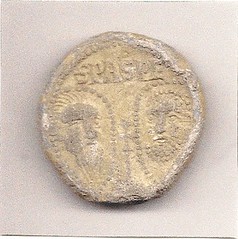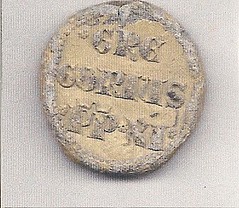
PREV ARTICLE
NEXT ARTICLE
FULL ISSUE
PREV FULL ISSUE
A LOT OF BULL: PAPAL BULLAS
John Linhoss submitted the following article on an Papal Bullas. Thanks! Are any of our readers familiar with these?
-Editor
Papal Bullas are now being found at the Baltimore coin shows. Although not a coin or a medal, why are they sold from a dealer's case? Being a collector of items considered "off the wall" in the numismatic world, I collect such items as love tokens, 18th century calendar tokens, game counters, communion tokens, etc., I have always had an eye for the unusual with a story. In 2006 I went to the spring coin show in Baltimore. While at a table "The Sentry Box", I was speaking with Chris Maniscalco ( a well respected and top shelf dealer ), when I noticed an unusual shaped item in one of his cases. I quickly pointed it out to him. Chris handed it to me. He described the piece as a "papal bulla". Oh, this was something new. I had to know more. He told me it was a seal the pope used to authenticate a letter he had written. Needless to say, I had to buy it. On my return trip home, it dawned on me that maybe I had one in an old box of coins and items left to research I had put away. With further investigation I discovered that I did have one and didn't know what it was for over 5 years. The piece I discovered was in fact a bulla from the 14th century. It had been used by Pope Gregory XI. The bulla gets its name from the seal on a "papal bull". The bull, simply put is a statement that the pope makes that clarifies an issue of doctrine, a statement that defends the Catholic Church against opposition or an official position on an event. Before the 14th century the term "bull" referred to "decrees" (issues affecting the entire Catholic faith), "constitutions" (instructions to a region or the whole faith), "encyclicals" (letters to bishops), and "decretals / rescripts" ( replies to a specific issue and letters of answer). The bull lends itself to the seal that makes the document official. From its conception, the seals were made from metal, usually lead alloy. To the eye of the day, it looked like a bubble of boiling water. Hence, the Latin word "to boil" is "bullire". With this authentication made by the pope, the documents consequently were referred to as "bulls". The seal itself was called a "bulla". Pope Gregory XI reigned from 1370 to 1378. During his reign as pontiff, enduring measures were taken against burning at the stake and property confiscation. This was widely accepted in England, Germany, and various parts of Europe. To this, he wrote many decrees, decretals, and rescripts explaining the position of the church. This, however, is another story.


The bulla pictured here is between to 635 and 643 years old. The common practice was to either run a silk or a hemp cord through the center of the seal. A silk cord for letters of instruction or reply and a hemp cord for excommunication were most often used.
At the subsequent shows in Baltimore since 2006, I have found 4 more bullas at 3 different dealer tables. A very affordable artifact for such a valuable history.
The Numismatic Bibliomania Society is a non-profit organization promoting numismatic literature. See our web site at coinbooks.org. To submit items for publication in The E-Sylum, write to the Editor at this address: whomren@gmail.com To subscribe go to: https://my.binhost.com/lists/listinfo/esylum All Rights Reserved. NBS Home Page Contact the NBS webmaster 
|